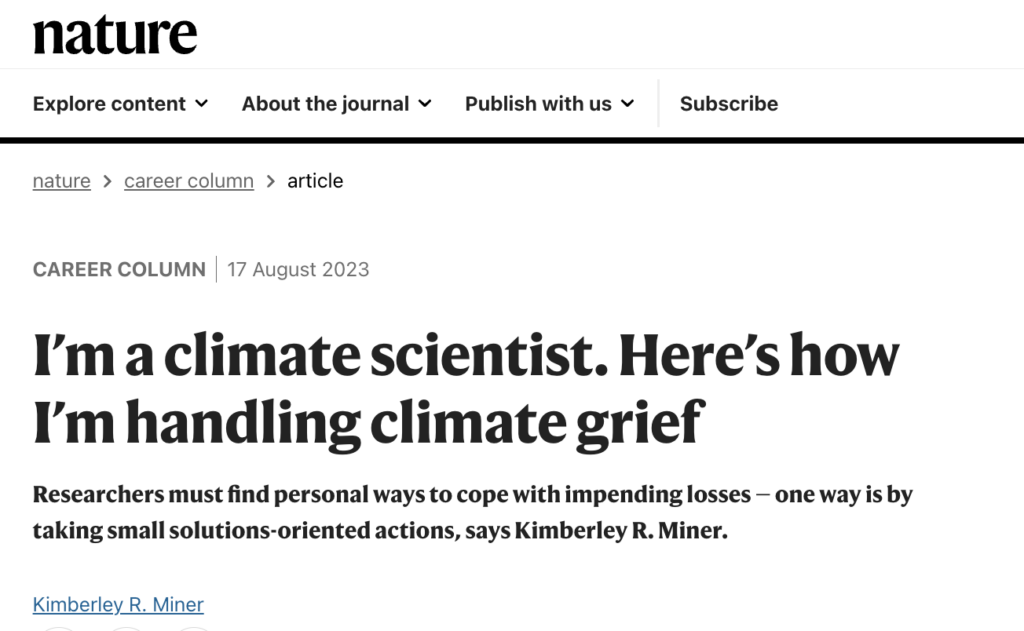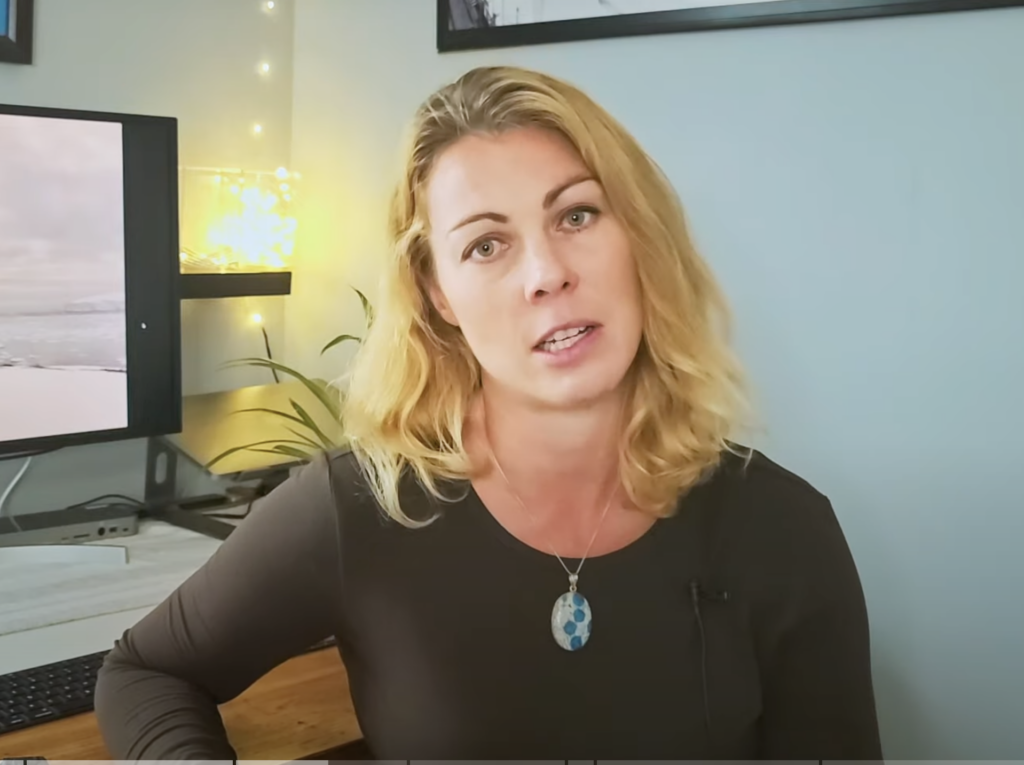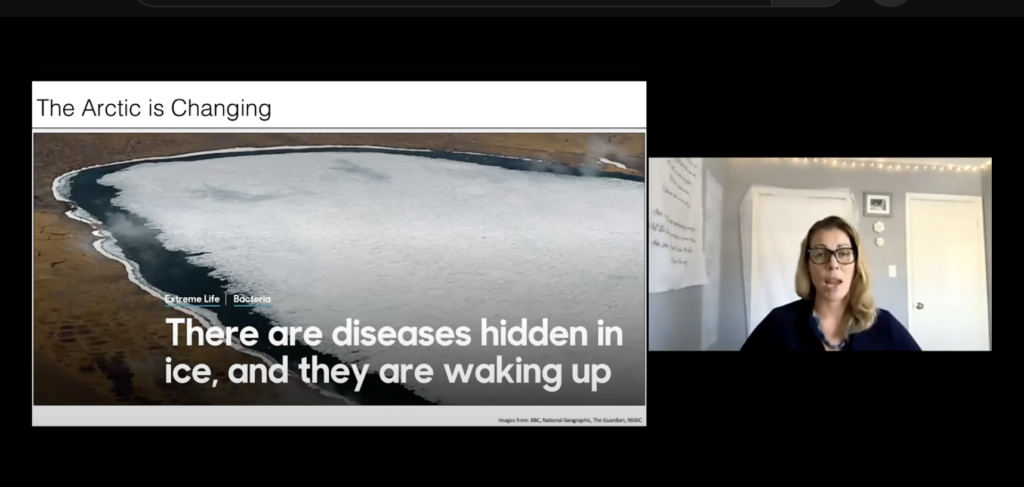https://www.nature.com/articles/d41586-023-02619-0
By Kimberley R. Miner

Last September, before the rains came, my field team learnt that it was probably too late for half the blue oaks affected by California’s drought in the region in which we were working. Because of years of ongoing drought, many of the trees would not recover from the long-term water loss and would die. The next morning, I sat outside our science team meeting and cried.
A friend sat with me and explained that she had just recovered from an episode of extreme climate grief brought about by studying rapidly changing terrestrial ecosystems. She had started taking weekends off (many of us work seven days a week) and encouraged me to do so, as well. After we talked, I walked around the parking area for a while, listening to the birds and watching the midday light filter through the diverse trees in downtown Santa Barbara. I breathed the ocean air and grounded myself in the present, where the air was cool and the birds were singing.
New article out yesterdayhttps://t.co/3GuwGXJG9h
— Dr. Kimberley R. Miner (@DrKimberley) August 18, 2023
Soon after that, I started taking weekends off to kayak near my home in Southern California and hike on the trails above Pasadena, and built a small bird garden on the porch of my apartment. I also started talking frankly to my colleagues about the emotional turmoil that is often sparked by working as a climate scientist today, and many others had similar stories. I am in my mid-thirties, working at NASA as a scientist, and I already have five scientist friends with severe, emergent health challenges. They are all affected by overwork, exhaustion and extreme stress. The only other thing they all have in common is that they study climate change.
Climate scientists have advocated for recognition of the destabilization of Earth’s ecosystems for four decades. Even within my lifetime, the climate system has changed noticeably, with hotter summers, longer dry periods and more frequent and severe storms. Some climate scientists have left the field, some have died and some have retired, but even more are just starting their careers. Early-career climate scientists across a range of fields are faced with comprehensive, esoteric challenges as ecosystems begin to cross tipping points. Knowing how to look at these huge changes and still be able to relax at the end of the day can be an ongoing problem.
Even for the most experienced and well-trained field scientists, changing dynamics can introduce sudden risks to health and safety. Whether in the shape of increased glacier flow rates, rainstorms that become atmospheric rivers, or abrupt permafrost thawing that disrupts sections of highway, these unforeseen risks are emerging increasingly. Scientists with decades of experience in one field location might find themselves confronted with a new atmospheric or hydrologic circulation pattern, an unseasonal storm or freeze, or literally shaky ground. Although we have a responsibility to track how certain sites are changing in a climate that’s getting hotter and more extreme, that can put scientists at considerable risk.
Recently, I spoke to Dave Schimel, one of the scientists who led the work for which the Intergovernmental Panel on Climate Change was awarded a Nobel prize in 2007, about how we can address climate grief. After decades of working to convince the public that climate change is real, he said that we need to work on solutions. He thinks that the current generation of climate scientists needs to move on from education and advocacy to providing solutions for mitigation, adaptation and resilience. The best treatment for climate grief, he says, is knowing you’ve made a contribution to reducing emissions or building resilience.
…


A life-sized statue of @DrKimberley Miner now stands at the @smithsonian, along with more than 120 IF/THEN® #WomenInSTEM Ambassadors. For #WomensHistoryMonth, we spoke with Kimberley about inspiring future #STEM leaders and what she’s working on at NASA: https://t.co/EVcjxtRYVc pic.twitter.com/n2o0n8boq6
— Switzer Foundation (@switzernetwork) March 17, 2022
2020 presentation: Impacts of Permafrost Degradation with Dr. Kimberly R. Miner

Being sassy at the @dallasarboretum! Come see our statues until 4pm today! @IfThenSheCan pic.twitter.com/zXeIaYWgdY
— Dr. Kimberley R. Miner (@DrKimberley) October 22, 2022
Getting the band back together again!
— Dr. Kimberley R. Miner (@DrKimberley) September 6, 2022
This fall, #IfThenSheCan – The Exhibit is back in Dallas You can find my @IfThenSheCan statue at the @dallasarboretum this Sept 9th – Dec 31st! https://t.co/Laqv8W1JzB pic.twitter.com/m2iVGydfNH
The @ifthenshecan Ambassadors are going to San Diego Comic-Con!
— Dr. Kimberley R. Miner (@DrKimberley) November 16, 2021
Join me @beatascienceart @clairemeaders @thesteamcollab and @PolycrystalhD for our panel STEAM Superstars at 5pm pacific on Saturday, November 27th! We'll be talking about our #science and #fandom! Join us! pic.twitter.com/jrG5xPELKG
Two great surprises came in the mail today!@NatGeo sent me a copy of the Guinness World Records book that our team is in (!) and @IfThenSheCan sent my statue.
— Dr. Kimberley R. Miner (@DrKimberley) November 3, 2021
So incredible to be part of an international STEM community Thanks for the support as we tackle the #climatecrisis pic.twitter.com/nVDGsfzbMG



